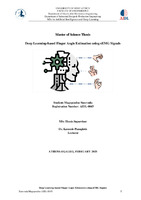Deep learning-based finger angle estimation using sEMG signals
Εκτίμηση γωνιών δακτύλων βασισμένη σε βαθιά μάθηση με χρήση σημάτων sEMG

Μεταπτυχιακή διπλωματική εργασία
Συγγραφέας
Μαγοπούλου, Σταυρούλα
Ημερομηνία
2025-03-06Επιβλέπων
Kasnesis, PanagiotisΛέξεις-κλειδιά
Deep learning ; Wearables ; sEMG signals ; Gesture recognition ; Joint angles ; RegressionΠερίληψη
This thesis focuses on creating and validating Neural Network architectures for hand gesture prediction based on electromyographic (EMG) signals generated by wearable devices. More specifically, it focuses on how deep learning approaches can be used for transforming raw physiological data into accurate, continuous-angle predictions of finger gestures. The study responds to an increasing demand for effective, end-user-friendly interfaces across prosthetics, rehabilitation and human–computer interface domains. Using the publicly available dataset NinaProDB5 as well as custom cross-validation schemes, this study systematically evaluates several network structures, data splits and hyperparameter options to determine what model architectures best map muscle activity to kinematic trajectories. The subsequent chapters provide the theoretical background of EMG signal acquisition and preprocessing after a review of relevant existing wearable technologies, focusing on the Thalmic Myo Band and CyberGlove II. Then, the basics of deep learning are discussed and how different architectures, such as Convolutional Neural Networks (CNNs), Recurrent Neural Networks (RNNs), Long Short-Term Memory (LSTM) units and Transformers can learn distinct aspects of spatiotemporal information from EMG signals, where each serves a specific purpose. Hybrid approaches, combining CNNs with LSTMs, are also explored to suitably model the complexities associated with the muscle activation patterns.
The methodology employs different cross-validation techniques, including k-fold and leave-one-subject-out, to assess the generalizability of the proposed models over various data segments and differences among individuals. To maintain uniformity, we leave the same set of hyperparameters (200 training epochs, 0.001 learning rate, 128 batch size) while testing on different configurations of data (21 vs 22 output dimensions, overlapping vs non-overlapping data and shuffled vs non-shuffled samples). We evaluate performance according to common regression metrics, namely Root Mean Square Error (RMSE), Mean Absolute Error (MAE) and R-squared (R²) score so that we have an overall view of absolute as well as relative model error. Results show that CNN-based architectures fit muscle activations’ data better than the other models, given enough training data and network complexity. Hybrid CNN-LSTM models as well as the Dual-Pathway CNN architecture provided moderate results overall, facing overfitting challenges. Additionally, the Transformer approach yielded results that were inconsistent and prone to non-convergence under the defined configurations. Through the discourse, we highlight the pros and cons of all the architectural types and how architectural depth should be traded off with computational tractability and overfitting, especially when variability between subjects is present. Final thoughts discuss hardware limitations, especially within real-time and embedded scenarios and propose paths for additional work including domain adaptation methods, fine-tuning neural architecture and hyperparameters, altering the preprocessing parameters. Collectively, this thesis shows how thoughtfully designed deep learning solutions can advance EMG-based hand motion prediction, making way for more natural, responsive interfaces and setting a path towards more exquisite future user experiences in the medical and consumer spaces.
Αριθμός σελίδων
128Σχολή
Σχολή ΜηχανικώνΑκαδημαϊκό Τμήμα
Τμήμα Ηλεκτρολόγων και Ηλεκτρονικών ΜηχανικώνΤμήμα Μηχανικών Βιομηχανικής Σχεδίασης και Παραγωγής

